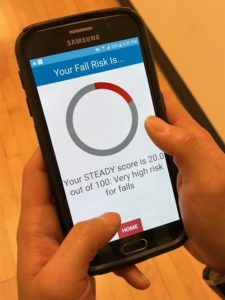by Katherine L. Hsieh.
Smartphones are everywhere these days, and it’s not surprising to find a health app on someone’s phone. From tracking physical activity to managing our diet, health apps have opened new opportunities in how we manage our health. Falls are a serious public health concern that can potentially be better managed through health app. Although falls are the leading cause of injury related death for older adults, they seldomly receive fall risk screening. Older adults may only see a clinician once a year, and equipment used for standard fall risk assessments are expensive for clinical use. With the ubiquitous nature of smartphones, there’s potential for health apps to provide fall risk assessment by measuring postural sway older adults.
Our research aimed to 1) test whether smartphone accelerometry could measure postural stability in older adults in a comparable way to a force plate, 2) determine if smartphone accelerometry can distinguish between older adults at low and high risk of falling, and 3) develop a fall risk app designed for specifically for older adults. Older adults performed seven different static balance tasks that challenged the available visual information and size of the base of support. Our results showed that root mean square acceleration derived from a smartphone was comparable to center of pressure velocity and 95% confidence ellipse derived from the force plate. Moreover, root mean square acceleration in the anteroposterior direction was able to distinguish between older adults at low and high fall risk based on the Physiological Profile Assessment. A fall risk app was then designed for the specific needs of older adults, and semi-structured interviews were performed to identify usability errors. The final product was an app that had high ease of use, provided individualized fall risk and had high perceived benefit among older adults.
Our study suggests that smartphones can be used as a tool to provide fall risk assessment for older adults. Health apps can improve overall health outcomes and offer the advantage of reaching a larger proportion of the population at a low cost. A fall risk app designed for older adults can provide them with the opportunity to self-manage their fall risk, receive individualized screening, and provide personalized treatment strategies. Leveraging smartphone apps that people already familiar with serves as an important step to provide fall risk screening in the home environment and prevent falls in older adults.

Figure: the STEADY app
Publications
Hsieh, K. L., Roach, K. L., Wajda, D. A., & Sosnoff, J. J. (2019). Smartphone technology can measure postural stability and discriminate fall risk in older adults. Gait & posture, 67, 160-165. https://doi.org/10.1016/j.gaitpost.2018.10.005
Hsieh, K. L., Fanning, J. T., Rogers, W. A., Wood, T. A., & Sosnoff, J. J. (2018). A Fall Risk mHealth App for Older Adults: Development and Usability Study. JMIR Aging, 1(2), e11569. https://doi.org/10.2196/11569
About the Author

Katherine L. Hsieh
University of Illinois at Urbana-Champaign
Katherine is currently a 3rd year PhD student at the University of Illinois at Urbana-Champaign. She works in the Motor Control Research Lab with Dr. Jacob Sosnoff and is interested in utilizing health technology for falls prevention in clinical populations.
Copyright
© 2019 by the author. Except as otherwise noted, the ISPGR blog, including its text and figures, is licensed under a Creative Commons Attribution-ShareAlike 4.0 International License. To view a copy of this license, visit https://creativecommons.org/licenses/by-sa/4.0/legalcode.
ISPGR blog (ISSN 2561-4703)
Are you interested in writing a blog post for the ISPGR website? If so, please email the ISGPR Secretariat with the following information:
- First and Last Name
- Institution/Affiliation
- Paper you will be referencing


